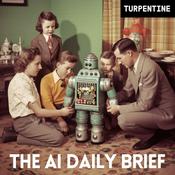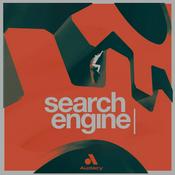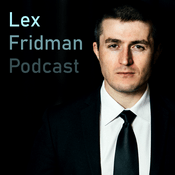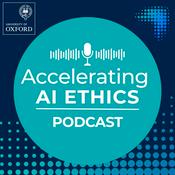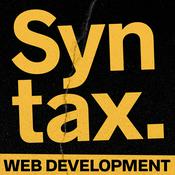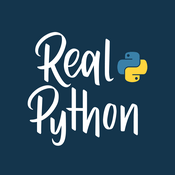The Daily AI Show

680 episodes

The Analog Sanctuary Conundrum
2026/1/10 | 48 mins.
For most of history, "privacy" meant being behind a closed door. Today, the door is irrelevant. We live within a ubiquitous "Cognitive Grid"—a network of AI that tracks our heart rates through smartwatches, analyzes our emotional states through city-wide cameras, and predicts our future needs through our data. This grid provides incredible safety; it can detect a heart attack before it happens or stop a crime before the first blow is struck. But it has also eliminated the "unobserved self." Soon, there will be no longer a space where a human can act, think, or fail without being nudged, optimized, or recorded by an algorithm. We are the first generation of humans who are never truly alone, and the psychological cost of this constant "optimization" is starting to show in a rise of chronic anxiety and a loss of human spontaneity.The Conundrum: As the "Cognitive Grid" becomes inescapable, do we establish legally protected "Analog Sanctuaries", entire neighborhoods or public buildings where all AI monitoring, data collection, and algorithmic "nudging" are physically jammed and prohibited, or do we forbid these zones because they create dangerous "black holes" for law enforcement and emergency services, effectively allowing the wealthy to buy their way out of the social contract while leaving the rest of society in a state of permanent surveillance?

Voice First AI Is Closer Than It Looks
2026/1/09 | 1h
On Friday’s show, the DAS crew shifted away from Claude Code and focused on how AI interfaces and ecosystems are changing in practice. The conversation opened with post CES reflections, including why the event felt underwhelming to many despite major infrastructure announcements from Nvidia. From there, the discussion moved into voice first AI workflows, how tools like Whisperflow and Monologue are changing daily interaction habits, and whether constant voice interaction reinforces or fixes human work patterns. The second half of the show covered a wide range of news, including ChatGPT Health and OpenAI’s healthcare push, Google’s expanding Gemini integrations, LM Arena’s business model, Sakana’s latest recursive evolution research, and emerging debates around decision traces, intuition, and the limits of agent autonomy inside organizations.Key Points DiscussedCES felt lighter on visible AI products, but infrastructure advances still matterNvidia’s Rubin architecture reinforces where real AI leverage is happeningVoice first tools like Whisperflow and Monologue are changing daily workflowsVoice interaction can increase speed, but may reduce concision without constraintsDifferent people adopt voice AI at very different rates and comfort levelsChatGPT Health and OpenAI for Healthcare signal deeper ecosystem lock inGoogle Gemini continues expanding across inbox, classroom, and productivity toolsAI Inbox concepts point toward summarization over raw email managementLM Arena’s valuation highlights the value of human preference dataSakana’s Digital Red Queen research shows recursive AI systems converging over timeEnterprise agents struggle without access to decision traces and contextual nuanceHuman intuition and judgment remain hard to encode into autonomous systemsTimestamps and Topics00:00:00 👋 Friday kickoff and show framing00:03:40 🎪 CES recap and why AI visibility felt muted00:07:30 🧠 Nvidia Rubin architecture and infrastructure signals00:11:45 🗣️ Voice first AI tools and shifting interaction habits00:18:20 🎙️ Whisperflow, Monologue, and personal adoption differences00:26:10 ✂️ Concision, thinking out loud, and AI as a silent listener00:34:40 🏥 ChatGPT Health and OpenAI’s healthcare expansion00:41:55 📬 Google Gemini, AI Inbox, and productivity integration00:49:10 📊 LM Arena valuation and evaluation economics00:53:40 🔁 Sakana Digital Red Queen and recursive evolution01:01:30 🧩 Decision traces, intuition, and limits of agent autonomy01:10:20 🏁 Final thoughts and weekend wrap upThe Daily AI Show Co Hosts: Andy Halliday, Beth Lyons, Brian Maucere, and Carl Yeh

Why Claude Code Is Pulling Ahead
2026/1/08 | 58 mins.
On Thursday’s show, the DAS crew spent most of the conversation unpacking why Claude Code has suddenly become a focal point for serious AI builders. The discussion centered on how Claude Code combines long running execution, recursive reasoning, and context compaction to handle real work without constant human intervention. The group walked through how Claude Code actually operates, why it feels different from chat based coding tools, and how pairing it with tools like Cursor changes what individuals and teams can realistically build. The show also explored skills, sub agents, markdown configuration files, and why basic technical literacy helps people guide these systems even if they never plan to “learn to code.”Key Points DiscussedClaude Code enables long running tasks that operate independently for extended periodsMost of its power comes from recursion, compaction, and task decomposition, not UI polishClaude Code works best when paired with clear skills, constraints, and structured filesUsing both Claude Desktop and the terminal together provides the best workflow todayYou do not need to be a traditional developer, but pattern literacy mattersSkills act as reusable instruction blocks that reduce token load and improve reliabilityClaude.md and opinionated style guides shape how Claude Code behaves over timeCursor’s dynamic context pairs well with Claude Code’s compaction approachPrompt packs are noise compared to real workflows and structured guidanceClaude Code signals a shift toward agentic systems that work, evaluate, and iterate on their ownTimestamps and Topics00:00:00 👋 Opening, Thursday show kickoff, Brian back on the show00:06:10 🧠 Why Claude Code is suddenly everywhere00:11:40 🔧 Claude Code plus n8n, JSON workflows, and real automation00:17:55 🚀 Andrej Karpathy, Opus 4.5, and why people are paying attention00:24:30 🧩 Recursive models, compaction, and long running execution00:32:10 🖥️ Desktop vs terminal, how people should actually start00:39:20 📄 Claude.md, skills, and opinionated style guides00:47:05 🔄 Cursor dynamic context and combining toolchains00:55:30 📉 Why benchmarks and prompt packs miss the point01:02:10 🏁 Wrapping Claude Code discussion and next stepsThe Daily AI Show Co Hosts: Andy Halliday, Beth Lyons, and Brian Maucere

The Problem With AI Benchmarks
2026/1/07 | 1h 7 mins.
On Wednesday’s show, the DAS crew focused on why measuring AI performance is becoming harder as systems move into real-time, multi-modal, and physical environments. The discussion centered on the limits of traditional benchmarks, why aggregate metrics fail to capture real behavior, and how AI evaluation breaks down once models operate continuously instead of in test snapshots. The crew also talked through real-world sensing, instrumentation, and why perception, context, and interpretation matter more than raw scores. The back half of the show explored how this affects trust, accountability, and how organizations should rethink validation as AI systems scale.Key Points DiscussedTraditional AI benchmarks fail in real-time and continuous environmentsAggregate metrics hide edge cases and failure modesMeasuring perception and interpretation is harder than measuring outputPhysical and sensor-driven AI exposes new evaluation gapsReal-world context matters more than static test performanceAI systems behave differently under live conditionsTrust requires observability, not just scoresOrganizations need new measurement frameworks for deployed AITimestamps and Topics00:00:17 👋 Opening and framing the measurement problem00:05:10 📊 Why benchmarks worked before and why they fail now00:11:45 ⏱️ Real-time measurement and continuous systems00:18:30 🌍 Context, sensing, and physical world complexity00:26:05 🔍 Aggregate metrics vs individual behavior00:33:40 ⚠️ Hidden failures and edge cases00:41:15 🧠 Interpretation, perception, and meaning00:48:50 🔁 Observability and system instrumentation00:56:10 📉 Why scores don’t equal trust01:03:20 🔮 Rethinking validation as AI scales01:07:40 🏁 Closing and what didn’t make the agenda

The Reality Check on AI Agents
2026/1/06 | 1h 5 mins.
On Tuesday’s show, the DAS crew focused almost entirely on AI agents, autonomy, and where the idea of “hands off” AI breaks down in practice. The discussion moved from agent hype into real operational limits, including reliability, context loss, decision authority, and human oversight. The crew unpacked why agents work best as coordinated systems rather than independent actors, how over automation creates new failure modes, and why organizations underestimate the cost of monitoring, correction, and trust. The second half of the show dug deeper into responsibility boundaries, escalation paths, and what realistic agent deployment actually looks like in production today.Key Points DiscussedFully autonomous agents remain unreliable in real world workflowsMost agent failures come from missing context and poor handoffsHumans still provide judgment, prioritization, and accountabilityCoordination layers matter more than individual agent capabilityOver automation increases hidden operational riskEscalation paths are critical for safe agent deployment“Set it and forget it” AI is mostly a mythAgents succeed when designed as assistive systems, not replacementsTimestamps and Topics00:00:18 👋 Opening and show setup00:03:10 🤖 Framing the agent autonomy problem00:07:45 ⚠️ Why fully autonomous agents fail in practice00:13:30 🧠 Context loss and decision quality issues00:19:40 🔁 Coordination layers vs standalone agents00:26:15 🧱 Human oversight and escalation paths00:33:50 📉 Hidden costs of over automation00:41:20 🧩 Responsibility, ownership, and trust00:49:05 🔮 What realistic agent deployment looks like today00:57:40 📋 How teams should scope agent authority01:04:40 🏁 Closing and reminders
More Technology podcasts
Trending Technology podcasts
About The Daily AI Show
Listen to The Daily AI Show, All-In with Chamath, Jason, Sacks & Friedberg and many other podcasts from around the world with the radio.net app

Get the free radio.net app
- Stations and podcasts to bookmark
- Stream via Wi-Fi or Bluetooth
- Supports Carplay & Android Auto
- Many other app features
Get the free radio.net app
- Stations and podcasts to bookmark
- Stream via Wi-Fi or Bluetooth
- Supports Carplay & Android Auto
- Many other app features


The Daily AI Show
download the app,
start listening.

